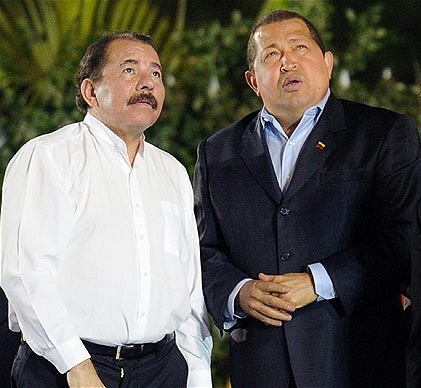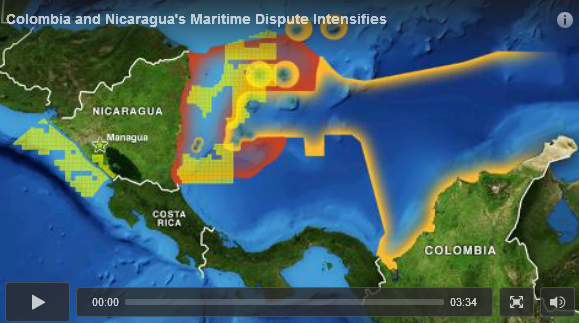What do they say about great minds? Seem that they do think alike. Here in a Statfor article, they examine the impact of the leader’s decision to remain in control.
Leftist Nicaraguan President Daniel Ortega appears set to rule for at least another term. A continuation of his presidency would further strengthen the control of the ruling Sandinista National Liberation Front, which proposed constitutional reforms Nov. 4 that could allow Ortega to be re-elected an unlimited number of times and to rule by decree, among other changes.
The reform initiative is likely planned to secure the ruling party’s stay in power for the foreseeable future and give Ortega time to name a political successor. The current government has the benefit of strong public support, a growing economy and few credible political opponents. As a result, Ortega’s reforms will probably be approved by the National Assembly in early 2014.
Analysis
The planned changes would remove clauses prohibiting presidents from seeking re-election or serving consecutive terms, as laid down in Article 147 of the constitution. Members of Nicaragua’s Independent Liberal Party — which is the main opposition to the ruling Sandinistas — have claimed that this will allow Ortega to rule indefinitely, so long as he retains the majority of public support.
The Sandinista National Liberation Front plans several other changes to the constitution. These changes will allow the president to rule by decree in unspecified administrative matters. In addition, a prohibition on military officers serving in government positions would be lifted, and Nicaragua’s disputed territory — gained from Colombia through an International Court of Justice ruling in 2012 — would be included in the constitutional definition of the country’s boundaries.
Although the planned amendments would give Ortega a fourth term as president, his leadership dates back to 1979, when he was the leader of Nicaragua’s post-revolutionary junta. Ortega assumed full presidential control from 1984 to 1990 and made Nicaragua a key Soviet ally in Central America. After a 17-year hiatus, Ortega returned to power in 2007 after brokering a political deal with former President Arnoldo Aleman. The deal lowered the vote threshold for becoming president, enabling the Sandinistas to win the presidential election in 2006. In 2010, the Nicaraguan Supreme Court allowed Ortega to run for an additional four-year term from 2011 onward, despite an existing constitutional prohibition.
Ortega will most likely use the political reorganization to preempt challenges to his party’s rule. The Sandinistas are planning for the future at a time when they face few constraints in ruling Nicaragua. The party holds 62 of 92 seats in the National Assembly, having achieved 62 percent of the vote in the 2011 presidential election, and has overall political control of 134 out of 153 municipalities nationwide. Another presidential term would also give the 67-year-old Ortega time to appoint a political successor. A pro-government lawmaker suggested that Ortega’s wife, Rosario Murillo, might be a future Sandinista presidential candidate.
An Uphill Battle for Opponents
The reforms coincide with a period of Nicaraguan economic and social stability. According to the Nicaraguan Central Bank, foreign direct investment in the country rose from around $381.7 million in 2007 to $810 million in 2012. Nicaragua’s average minimum wage of $160 per year, which is the lowest in Central America, has made the country competitive in low-end manufacturing. Nicaragua is also relatively safe compared to other Central American nations. It has avoided the high murder rates and violence associated with drug trafficking that have affected Honduras, Guatemala and El Salvador. These factors are expected to ensure that public approval for the Sandinista government and its populist policies will remain high ahead of the next presidential election, which is scheduled for November 2016.
The changes to the constitution are unlikely to face any immediate challenges from Nicaragua’s political opposition. The Independent Liberal Party only holds 27 seats in the National Assembly, a weakness that prevents it from rejecting the government’s constitutional initiative outright. Independent Nicaraguan newspapers have also reported that some opposition members have agreed to accept Ortega’s amendments to the constitution in exchange for governmental posts or ambassadorships. Given its political ineffectiveness and alleged acquiescence to Ortega’s terms, the opposition party cannot realistically prevent any of the constitutional revisions.
The reforms stand a good chance of being approved mainly because of high unity within the Sandinistas. The party has no major political leaders besides Ortega and his wife and no significant dissident factions. There is also no obvious challenge to Sandinista rule from within the military, due to the fact that many of its commanders rose through the officer corps during Ortega’s first term. The president’s brother, Humberto Ortega Saavedra, also led the Nicaraguan armed forces from 1979 until 1995.
Given the rising Nicaraguan economy and the Sandinistas’ popularity and continuity, if the constitutional changes are approved any political opponent to Ortega in 2016 will face an uphill battle. At the very least, the reforms will in all probability ensure that Ortega’s administration can effectively manage the opposition and remain in control of Nicaragua for another four-year presidential term.

